I never thought I would eat at elBulli – even before it closed last year, the reservations process was hit-or-miss to put it mildly, and dinner would require flying to Spain.
Thanks to Next, though, I’ve had an elBulli experience that even the original itself couldn’t provide, a sort of time-traveling retrospective of dishes that has been carefully curated by Chefs Achatz and Beran. Some of these are innovative in terms of technique, and others are memorable or evocative for the chefs (Achatz spent a few weeks there in 2000 as a stage, and both have dined there).
Before our dinner rolled around, I spent some time reading reports from the actual elBulli, which made me even more excited – these two are particularly great. I avoided articles and photos about Next: elBulli, though, since I wanted to draw out the fun of anticipation as much as possible.
So when we sat down, I had a vague idea of what was to come (namely, 29 courses and some of the most classic elBulli dishes). Mostly, though, I was just excited, and eager to see how the experience would unfold. What would spherical olives taste like? Could I even eat 29 courses? Let’s find out…
So when we sat down, I had a vague idea of what was to come (namely, 29 courses and some of the most classic elBulli dishes). Mostly, though, I was just excited, and eager to see how the experience would unfold. What would spherical olives taste like? Could I even eat 29 courses? Let’s find out…
#967 Nitro caipirinha with tarragon concentrate (2004) – an icy cachaca slush served in a hollowed-out lime half, with just the smallest dollop of tarragon on the tip of a spoon – after stirring together, you get essentially a high-end caipirinha slushie. (And it’s strong!) After a few bites of this, I could feel the chill of a snowy Chicago night slipping away.
Note: Each dish is identified by its number in the elBulli catalog as well as the year it originated.
#644 Hot/cold trout roe tempura (2000) – at first glance (and taste), reminded me of the PB&J from Next: Childhood; then the warmth of the tempura coating gave way to a mass of cool, exploding roe and a bit of cream. I was particularly enamored of the beautiful, handmade service piece – a sort of molded silver screen.
To drink: a glass of Jane Ventura “Brut Natura” 2008 cava, for a classic pairing.
#1095 Spherical olives (2005) – one of elBulli’s most iconic dishes (and the one that the chefs at Next started working on first), so I knew this one was coming. The olives arrive at the table in a small jar, looking quite unremarkable, but when they’re fished carefully out and deposited on small spoons, it becomes obvious that these are no ordinary olives. They jiggle. Eat them in one bite and they pop, releasing a burst of intense olive flavor – a bit thicker than liquid, and a bit thinner than puree. These are olives elevated to the sublime.
#105 Coca of avocado pear, anchovies, and green onion (1991) – the flurry of tapas-style dishes continued with a crostini-like bite featuring a picture-perfect piece of anchovy.
#859 Iberico sandwich (2003) – featuring an “air baguette” wrapped with a piece of Iberico ham. The “baguette” was essentially a perfectly formed air bubble, with a paper-thin, cracker-crisp exterior.
#741 Golden egg (2001) – a quail egg yolk dipped in what looked like liquid gold. In fact, it was a sweet, caramelized coating that crunched and stuck to our teeth like nougat – unexpected and fun.
To drink: the same cava, but now transformed with the addition of Pineau de Charentes (French fortified wine) and Farigoule (Provencal thyme liqueur). These were delivered in tiny vials, left for us to combine with our cava in whatever proportion we wanted.
#1361 Black sesame spongecake and miso (2007) – beautiful to look at, with a wonderful airy texture and a deep, earthy flavor. I can only describe it as tasting like dirt, in the best possible way. Definitely a stand out.
#474 Chicken liquid croquettes (1998) – tiny fried nuggets (like the tip of my pinky finger) filled, as the name suggests, with warm “chicken liquid.” Exactly what it sounds like.
#400 Smoke foam (1997) – again, the name says it all. This was a small glass filled with warm foam with a delicate smoky flavor, topped with two croutons. Many of these early dishes are quite singular in their focus, either one bite or one flavor (or both).
To drink: a second transformation of our cava, this time with Malaga Moscatel (Spanish fortified wine) and Reagan’s orange bitters. Instead of a vial, these came in an eyedropper bottle. The cava went from crisp and bright to herbal and sweeter as we progressed.
#878 Carrot air with coconut milk (2003) – a goldfish bowl-sized glass dish filled with bright orange bubbles, the “carrot air.” Again, the flavor and aroma were intense and pure, like the sweetest and freshest raw carrots. After the first few bites, I discovered curry broth and a sort of coconut milk custard at the bottom of the bowl beneath the voluminous bubbles, which added depth and complexity to the carrot flavor.
#416 Cuttlefish and coconut ravioli (1997) – a simple presentation, just a single white bundle on a sparsely garnished plate with Asian flavors. A thin sheet of cuttlefish is folded around a coconut milk center, leading to a juxtaposition between the chewy exterior and delicious liquid interior. For those counting, we’re at dish 11, less than halfway through.
To drink: Velvety and fragrant Bride of the Fox sake.
#159 Savory tomato ice with oregano and almond milk pudding (1992) – considering that it’s February, frozen tomato seems appropriate, but the flavor was surprisingly summery and lovely. The almond pudding in the bottom provided contrasting texture, similar to the cuttlefish – melting sharpness of ice against the creamy, warmer pudding.
#781 Hot crab aspic with mini corn cous-cous (2001) – from the cold ice, we careened to the other end of the temperature spectrum with a hot aspic surrounding three pieces of crab. I found the aspic too salty, so ended up picking out the crab and eating it separately.
To drink: Domaine Bordatto “Basa Jaun” cider from France. One whiff and we agreed – intense barnyard. The flavor was earthy, tart, apple-y, and thankfully less farm-like. D loved it, but I wasn’t as much of a fan.
#671 Cauliflower cous-cous with solid aromatic herb sauce (2000) – one of the prettiest presentations, very reminiscent of the way dishes are plated at Alinea. The “solid sauce” is in fact a collection of garnishes, including herbs, Campari gel cubes, nuts, and flowers.
#28 Suquet of prawns (1988) – our server described this as a “sea and mountains” dish (Catalonian equivalent of “surf and turf”), with the prawns representing the sea and the potato spheres the mountains. The star of the dish was, to me, the richly ocean-infused sauce made with shrimp heads.
In the picture, you can see the shadow of the red rose that hung above our table and spun lazily in place.
In the picture, you can see the shadow of the red rose that hung above our table and spun lazily in place.
To drink: sherry, specifically Emilio Hidalgo “Marques de Rodil.” I really need to start drinking sherry more often – it’s great.
#491 Tortilla de patatas by Marc Singla (1998) – to avoid any confusion, I’ll go with the Spanish name here instead of “potato tortilla.” I have fond memories, from my time working in Menlo Park, of crossing the CalTrain tracks behind my office to get to the little gourmet shop attached to Iberia restaurant, where I would buy a slice of tortilla de patatas for lunch – a sort of omelette cake made of potato, onion, and egg. Here, the potato appeared as a creamy hot foam, with sabayon and caramelized onions. Entirely wonderful.
#52 Trumpet carpaccio (1989) – the innovation here, from over two decades ago, was less about cooking technique and more about the concept – turning a garnish (vegetables) into the main focus of the dish and meat into the garnish. This is my mother’s dream come true! The carpaccio of thinly sliced mushroom stems was silky and tender, almost unidentifiable as mushroom; on top, a whole mushroom cap that served as the trompe l’oeil meat element. The only actual meat was a few pieces of rabbit kidney placed decoratively over the carpaccio.
#10 Red mullet gaudi (1987) – another dish from the “distant” past, featuring stunning knifework to create a brunoise of vegetables that form a Gaudi-esque mosaic atop the mullet fillet. This course was served on a glass plate placed over a bag of hot water filled with shells, for a visual treat.
To drink: Prioriat, Francesc Sanchez Bas “Montgarnatx” 2009. This was a rich and well-structured red wine, earthy yet with hints of fruit and minerality. We also had another red wine before this one, but since it doesn’t appear on my menu, I can’t remember the details. (I’m pretty sure I’m not imagining it.)
#1404 Nasturtium with eel, bone marrow, and cucumber (2007) – just three bites, a respite from the larger sized dishes in this phase of the menu. From left to right, we had eel and bone marrow on a large nasturtium leaf, then a nasturtium flower, and then a pretty disk of cucumber on a small leaf. The richness of the mouth-coating bone marrow and eel was almost overwhelming after so many courses before, but it was cut a bit by the spicy flower and then refreshing cucumber.
To drink: custom-made Half Acre beer, designed especially for this menu – “Sanguis” ale, made with beets and orange.
#686 Civet of rabbit with hot apple jelly (2000) – lean and tender stewed rabbit in a wine sauce, served with two cubes of apple jelly. The plate was streaked on either side with a foie gras-enriched sauce and speckled with cocoa powder; I never would have considered chocolate with rabbit, but the slight bitterness added great depth of flavor. Alas, I was starting to get full, so regretfully watched a few unfinished bites go back to the kitchen. If you’re scoring at home, this is course 20.
#1570 Gorgonzola balloon (2009) – this looks for all the world like a giant white dinosaur egg. Our server used a spoon to crack open the top of the frozen hollow sphere, then grated fresh nutmeg over it and left us to use our fingers to break off pieces. They tasted remarkably just like gorgonzola, despite having been turned into such a different form. The thin pieces started to melt on our hands if we ate too slowly, and before too long, the remains of the balloon collapsed. The bracing flavor of the cheese seemed to reset my palate, and I was able to forge ahead.
#580 Foie gras caramel custard (1999) – like a creme caramel, but made with foie gras instead of sugar. Silky, rich, and surprisingly delicate in flavor.
To drink: more sherry, Gonzalez-Byass Apostoles Palo Cortado “Muy Viejo”. I liked this even better than the first one.
#367 Spice plate (1996) – apparently this course was inspired by a meal at a Chinese restaurant where Chef Adria and his companions encountered an unusual spice on one of their dishes and each tried to identify it, as a sort of competition to find out who had the most discerning palate. Here, we had twelve different spices placed around the edges of a shallow dish of apple gelee, and a card where we could match each spice to its corresponding position. My competitive nature made this one of my favorite parts of the dinner – I carefully examined and tasted each tiny bit of spice, and to my everlasting satisfaction, got a perfect score. In my excitement, though, I neglected to take a picture until I had mostly finished tasting.
#1647 Mint pond (2009) – I would never have imagined that ice could become a wonderful dessert. Literally: plain frozen water, topped tableside with powdered peppermint, matcha, and muscovado sugar. We broke through the thin sheet of ice with our spoons, combining the white and green and brown powders in the bottom of the bowl along with shards of ice. The intense flavors, combined with the cool watery bits of ice, really do make this seem like eating a frozen, minty pond.
#439 Chocolate in textures (1997) – as one who adores dark chocolate, I couldn’t have asked for a better dessert than this. The “textures” included chocolate cake, chocolate mousse-like cream, crisp chocolate tuiles, and a ridiculously good chocolate ice cream. The taste of the chocolate came through with perfect clarity, and the ice cream was lush and creamy, with none of the dulling flavors of dairy.
#1820 Chocolate donuts (2010) – as the meal winds down, we returned to two of the repeating themes – exploding centers and coconut. Here, it’s a cold chocolate “donut” filled with liquid coconut.
To drink – a midnight-dark dessert wine, Casa de la Ermita Dulce Monastrell, Jumilla 2006. Sweet and deeply fruity.
#225 Creme flute (1993) – very simple, a curled cookie cylinder as thin as a tuile, with delicate flavor.
#66 Puff pastry web (1989) – paired with the flute, this is another straightforward crispy treat, a sort of swirling, free-form, openwork cookie.
To drink: Spanish coffee with a jellied “sugar cube” made of sherry and tequila, which melted instantly when dropped into the cup.
#1089 Passionfruit marshmallow – the farewell (2004) – hard to believe that we had reached the end! By this point it was just about midnight, nearly five hours after our arrival. Our server placed three “hands” in front of us, inflated surgical gloves atop round silver bowls that swayed and waved. Two of the bowls were empty, the third held a handful of mini marshmallows infused with passionfruit – a whimsical presentation of mignardises that were a light and refreshing finale after the marathon of flavors that had come before.
The menu is long (just under five hours for us), but it’s obvious that great care has gone into its development. Thanks to the wide variety of textures and flavors, the balance across courses, and the small size of many of the dishes, I was full but not overwhelmed as we headed out of the restaurant.
And I was very happy.
And I was very happy.


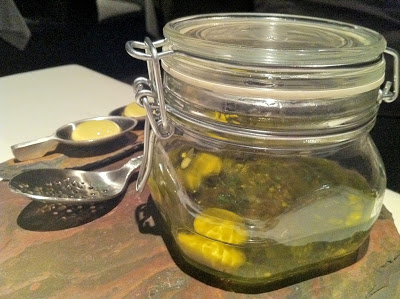
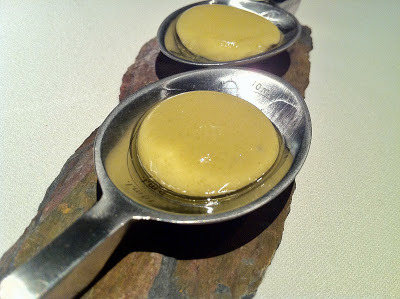

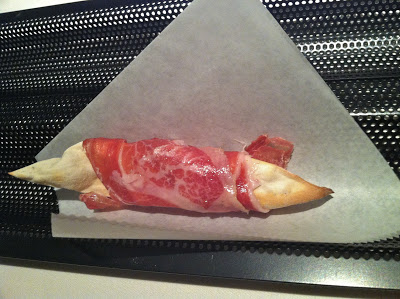
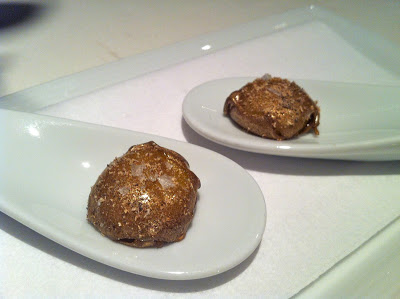
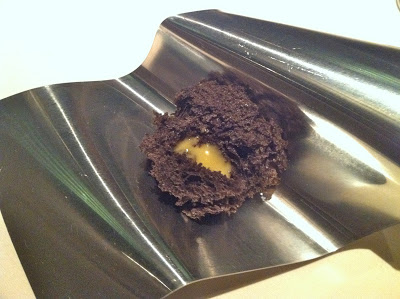
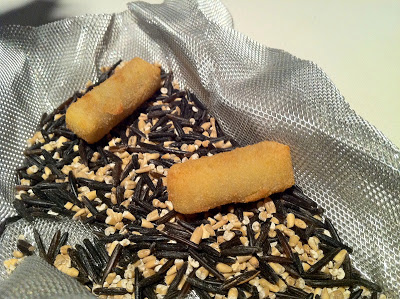

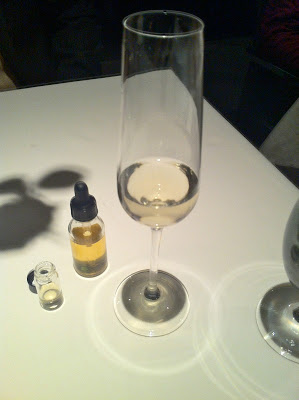
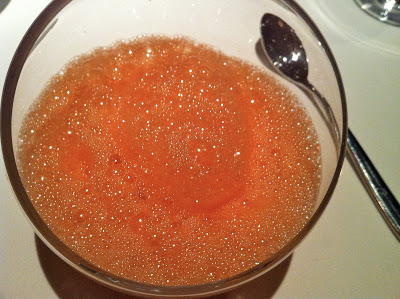
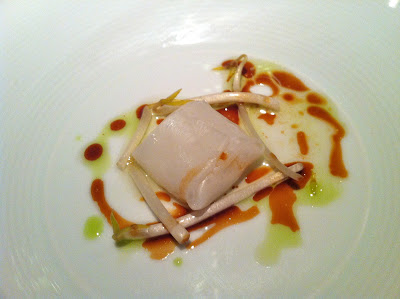
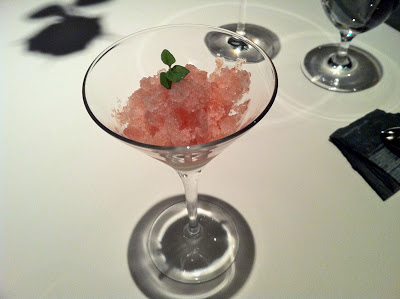
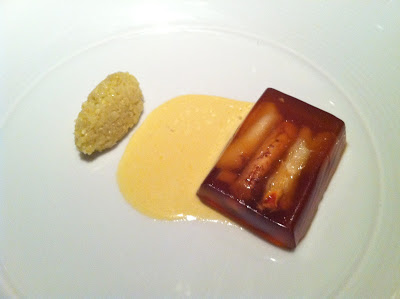
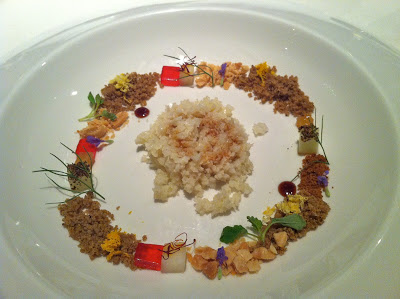
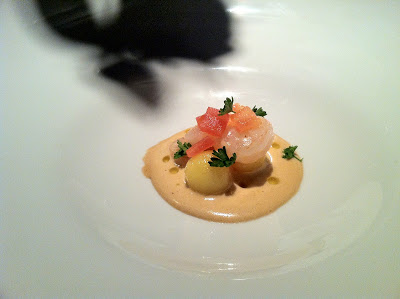
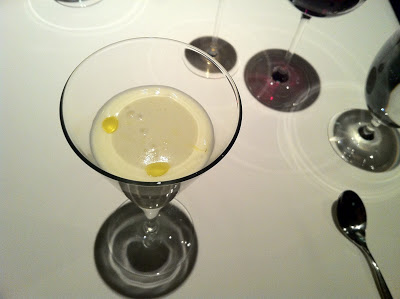
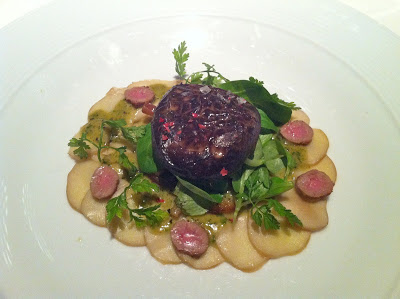
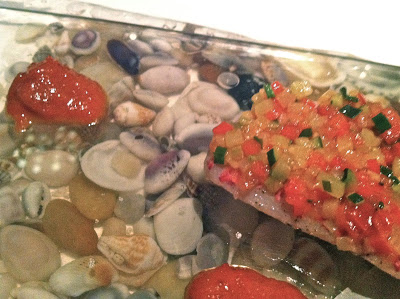
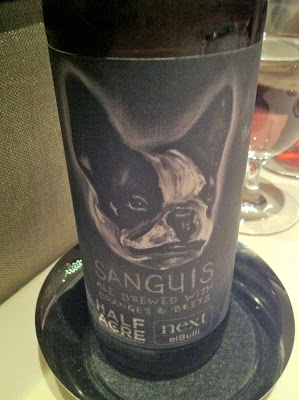
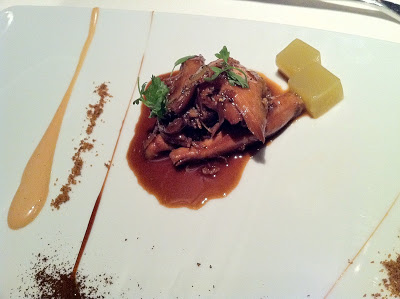
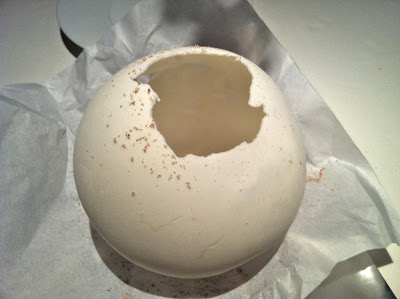
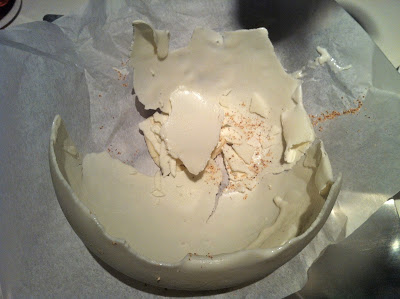
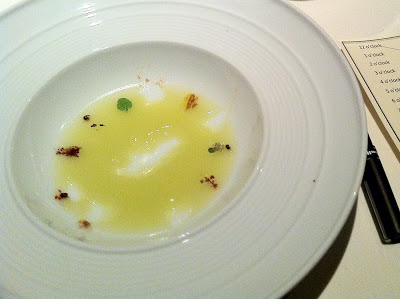
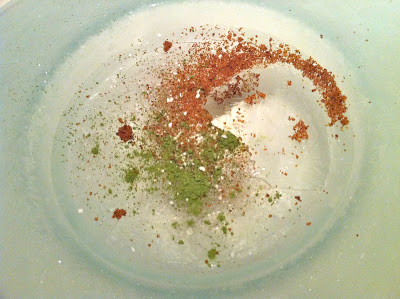
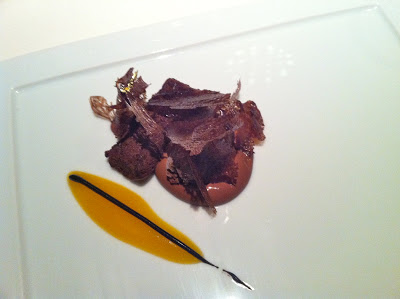
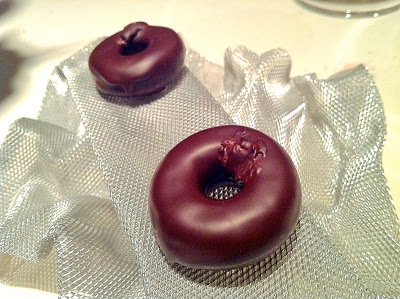
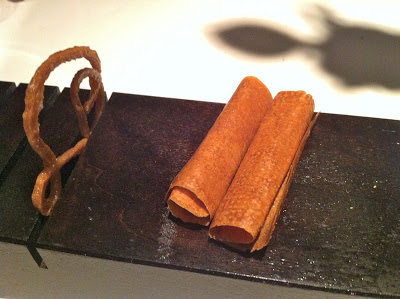
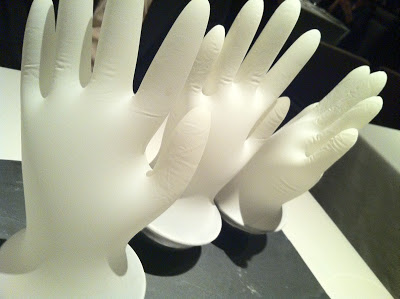
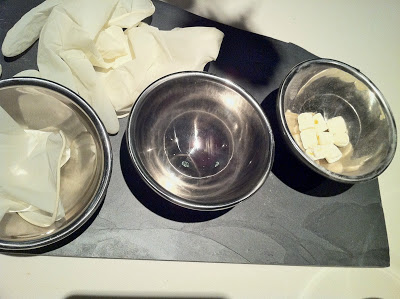

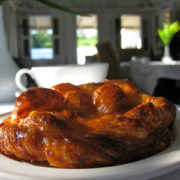 Koal Keel and Le Petit Patissier, Anguilla
Koal Keel and Le Petit Patissier, Anguilla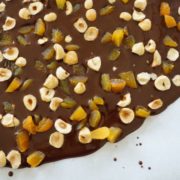 Chocolate bark
Chocolate bark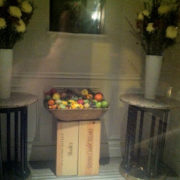 Vegetable Menu at Charlie Trotter’s
Vegetable Menu at Charlie Trotter’s All around Paris
All around Paris
Thank you for a truly wonderful and through description of a legendary evening.